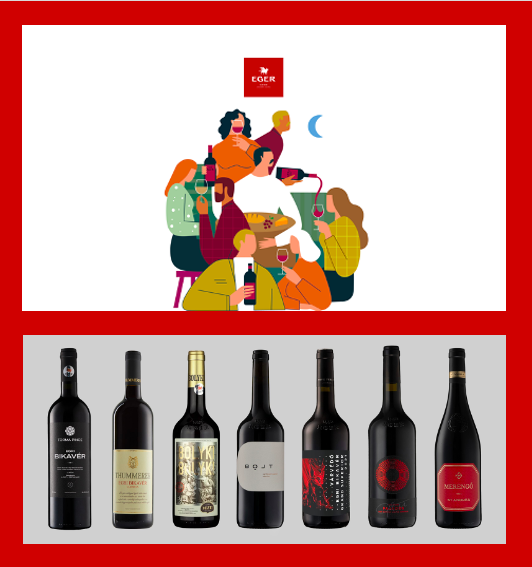“Bloody” legends and crystal clear regulations
Two tools that help selling Egri Bikavér
Wine has to be of outstanding quality to achieve international fame, that’s obvious – and unfortunately it is not enough to sell the wine. For the success a good story is useful, plus clear, strict regulations are needed so that the same quality could be guaranteed every year. Egri Bikavér (aka Bull’s Blood of Eger) has both, thus it is high time to rediscover this amazing wine. Szekszárd, the other appellation of Bikavér has its stories and regulations as well, but this time we cover the story of Egri Bikavér.
Special thanks to Éva Barta, export manager of Tóth Ferenc Winery, author of the article below. If you are interested in the whole of Eger wine regulation, click here (also special thanks to Éva Barta for editing and translating the regulations).
The Mighty Castle Guards
 There are numerous folk tales recounting how the name ‘bikaver’ originated during the Turkish siege of Eger Castle. It is believed that at the time of the standoff of 1552, when the soldiers were exhausted from the continuous, energv-sapping fight, castle captain Istvan Dobo opened the cellars, and generously served wine to his soldiers. They, not surprisingly, were very thirsty and in their eagerness to drink the ruby red wine ran down their faces all over their beards, moustaches and armour. The Turkish, who were attacking the castle, saw the red liquid on the faces and clothes of the Hungarians and, assuming it was bull’s blood, attributed their great strength to it.
There are numerous folk tales recounting how the name ‘bikaver’ originated during the Turkish siege of Eger Castle. It is believed that at the time of the standoff of 1552, when the soldiers were exhausted from the continuous, energv-sapping fight, castle captain Istvan Dobo opened the cellars, and generously served wine to his soldiers. They, not surprisingly, were very thirsty and in their eagerness to drink the ruby red wine ran down their faces all over their beards, moustaches and armour. The Turkish, who were attacking the castle, saw the red liquid on the faces and clothes of the Hungarians and, assuming it was bull’s blood, attributed their great strength to it.
The Story of Ahmed Pasha and the Bikaver
Another story also confirms that the name ‘Bikaver’ comes from the times of the siege of 1552. What happened was that Ahmed Pasha, who was the leader of one of the Turkish armies, fancied one of the maids who was serving at a local inn. The inn-keeper and the staff did not have enough time to flee before the attacking army arrived, so they stayed resigned to their fate, but the Turkish did not kill them. On the contrary, the pasha employed the inn-keeper’s wife as a cook, This woman had a maid who was renowned for her beauty. The pasha laid eyes on her and decided to make her one of his concubines. The girl did not take this as a compliment, instead she was rather scared and embarrassed, and so she asked the inn-keeper’s wife to save her. She promised the maid to do everything she could in order to prevent the pasha from having her.
There was a big dinner at the inn on the night before the siege, and the inn-keeper’s wife prepared a delicious, special sauce to accompany the heavy meat. It was so tasty, that the pasha could not stop eating the red sauce, and after a while he started drinking it from a cup. The alcohol made him disoriented, so he lay down to sleep. By the next morning, the maid had escaped from the tent and was nowhere to be seen. Ahmed Pasha was furious, and accused the cook of adding some secret substance to the sauce, something that had caused him to fall unconscious. The cook defended herself by stating that the only extra ingredient she had put in the food was bull’s blood, which was commonly consumed in Hungary. This is how the famous red wine of Eger became ‘Bikaver’ (Bull’s Blood). Whether Ahmed Pasha believed the cook or not has long been forgotten.

The legacy
Egri Bikaver is a red blend produced in Eger. It is the true essence of the red wines of Eger, a terroir wine, which carries the flavour of the soils of local production sites, the mezzo-climate unique to the region and the traditions and mores of local residents, from the selection of varieties to choosing the period and method of grape processing and mellowing.
The exact date of the emergence of Egri Bikaver is shrouded in mystery. One thing is certain; the word Bikaver (bull’s blood) was recorded as early as the beginning of the 19th century. Under the name Bikaver, full-bodied red wines were sold, not only in Eger and Szekszard but other places as well. Legends grew up around the name, which tied it to the 1552 siege of Eger as related by Gardonyi Geza.
In its present form, also accepted by the public, Egri Bikaver is associated with the name of Grober Jeno, Eger vigneron. Sugar Istvan (1981) writes: ‘I have searched different sources for the composition of grape types constituting bull’s blood. The earliest record dates back to 1912, when, in addition to kadarka, I have found blue frank, cabernet and merlot’.
Our contemporary vignerons and winemakers have been refining the conditions of the production, name, classification and control of this wine for the past two decades. The result of this activity is that Egri Bikaver became the first quality wine in Hungary’s history to be produced in a specified region. (Egri Bikaver Regulation of 1997)
Egri Bikavér – Heritage and legend

Illustration by Winefolly
Date of birth: 1552/Place of birth: Fortress of Eger
Ingredients: at least 3 grape varieties (Classic Bikaver), at least 5 varieties (Superior Bikaver+Grand Superior Bikaver)
Main variety: Kékfrankos
Other varieties: Kadarka (Gamza), Syrah, Merlot, Portugieser, Menoir, Blauburger, Zweigelt, Pinot Noir
Limited varieties: Cabernet Sauvignon + Cabernet Franc (a maximum of 30%) Turan + Purple Kadarka (a max. of 10%)
Ageing: in oak barrels for a minimum of 6 months for Classic, for a min. of 12 months for Superior, for a min. of 16 months for Grand Superior Character: dry
At present, Egri Bikaver is produced in accordance with a regulation designating 3 tiers of quality: classicus, superior and grand superior. The product description contains the rules of yield restriction, fermentation sur marc, ageing in barrels and bottles, as well as the marketing and trading of the wines, for the different tiers.
Egri Bikaver is a Kékfrankos-based dry red wine blend, ranging from garnet red to deep ruby, with flavours and aromas presenting rich, spicy and fruity characteristics, without a tannin accent. Aging and fresh fruit aromas are both characteristic of the wine; its complexity is well illustrated by the fact that the characteristic feature of the wine is that no single grape type can dominate the wine in question. Due to the riper, more concentrated grape produce, as well as the extended aging in barrels and bottles, Superior and Grand Superior wines have marked aromas of mellowing, lasting flavours, full body and a long shelf-life with minerality and ideas in harmony with the production areas (sites). The difference between them is usually manifested in the fullness and duration of the aroma.
Rules of blending
Classicus wines: blending of the wine of at least three grape types is obligatory; their percentage must exceed 5% respectively, and no variety may exceed 50%; the use of Kékfrankos is obligatory, and this variety must be blended in the highest percentage to make the wine; the percentage of Turan and Biborkadarka must not exceed 10 % either combined or respectively.
Superior and Grand Superior wines: blending of the wine of at least three grape tvpes obligatory; their percentage must exceed 5 respectively with the exception of Kékfrankos (which can be as rate as 50%), no variety may exceed 30%; Cabernet Franc and Cabernet Sauvignon must not represent more than 30% the blend either respectively or combined: and the blend must not contain more than 5% Turan.
One of the numerous great Bikavér wines
Tóth Ferenc Egri Bikavér Superior 2013 is an elegant expression of all the above written regulations. “A blend of the selection of the best base wines of the winery. Kékfrankos base, the three Bordeaux variety, Pinot Noir and Kadarka got the place in this blend. Velvety tannins, intense violet and plum fragrances combined with spicy sour and sweet cherry notes. Unusually rich bikavér style with serious structure and long finish.”
Comments ( 10 )
-
Trackback: dultogel
-
Trackback: วางท่อปลวก สมุย
-
Trackback: novo bar al6000
-
Trackback: aroundtravel
-
Trackback: safe dayz hacks
-
Trackback: กระเป๋าผ้ากระสอบ
-
Trackback: Diyala/baqubah/university/universal
-
Trackback: หญ้าเทียม
Comments are closed.







Trackback: dultogel